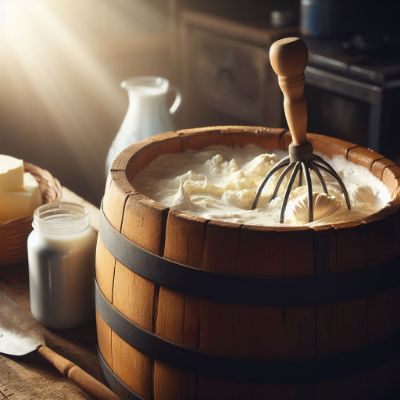Introduction:
Butter churning, a practice that dates back centuries, has evolved through various methods and tools. One of the most iconic and traditional ways of churning butter is by using a wooden barrel. This age-old technique not only produced a creamy and rich butter but also added a touch of nostalgia to the process. In this article, we'll explore the fascinating history and steps involved in churning butter using a barrel.
Historical Context:
The use of barrels for butter churning can be traced back to a time when communities relied on their own resources and manual labor to produce essential food items. Wooden barrels were readily available and became a popular choice due to their durability, easy handling, and suitability for the churning process. In rural households, the act of churning butter was often a communal effort, bringing together families and neighbors for a shared task.
Materials and Construction:
The barrels used for butter churning were typically made from sturdy wood, with a capacity that could accommodate a significant amount of cream. Oak and beech were commonly favored for their strength and resistance to odors. The barrels had a tightly fitting lid, ensuring that the cream would not leak during the churning process.
Churning Process:
The process of churning butter in a barrel was both simple and demanding. Here's a step-by-step guide to how it was done:
Cream Preparation:
- Fresh cream, obtained from cow's milk, was allowed to settle to the top. The cream was then skimmed and collected for the churning process.
Barrel Setup:
- A clean, sanitized barrel was chosen for churning. The barrel was filled with fresh cream, leaving enough space for expansion during the churning action.
Securing the Lid:
- The lid was tightly secured to prevent any spillage, and the barrel was placed on its side for easy rolling.
Churning Motion:
- The barrel was rolled back and forth or rocked using handles, providing the necessary agitation for the cream. This motion caused the fat molecules in the cream to come together, forming butter.
Monitoring the Progress:
- Churning could take a considerable amount of time, and patience was key. The churning progress was monitored by checking for the formation of butter clumps and the separation of buttermilk.
Draining and Washing:
- Once the butter had formed, the buttermilk was drained from the barrel. Cold, clean water was then added to the barrel, and the churning continued briefly to wash out any remaining buttermilk.
Shaping and Storage:
- The freshly churned butter was shaped into blocks or molded as desired. It could be salted at this stage for flavor. The butter was then stored in a cool place, such as a cellar or refrigerator, to firm up before consumption.
Conclusion:
Churning butter in a barrel not only produced a delicious and wholesome product but also served as a cultural and communal activity in many societies. While modern technology has introduced more efficient methods of butter production, the traditional use of barrels for churning remains a cherished part of culinary history.
Want to try it with our barrels, we have some open-top barrels just for this: https://www.barrelsonline.com/kombucha-and-vinegar-barrels


